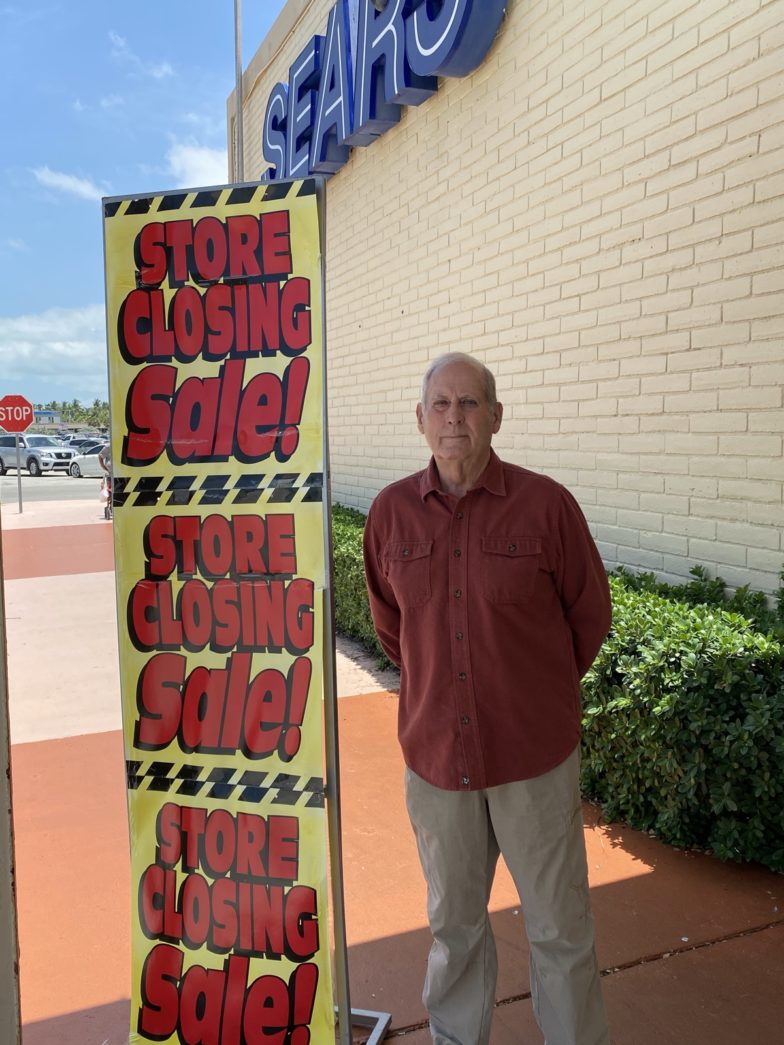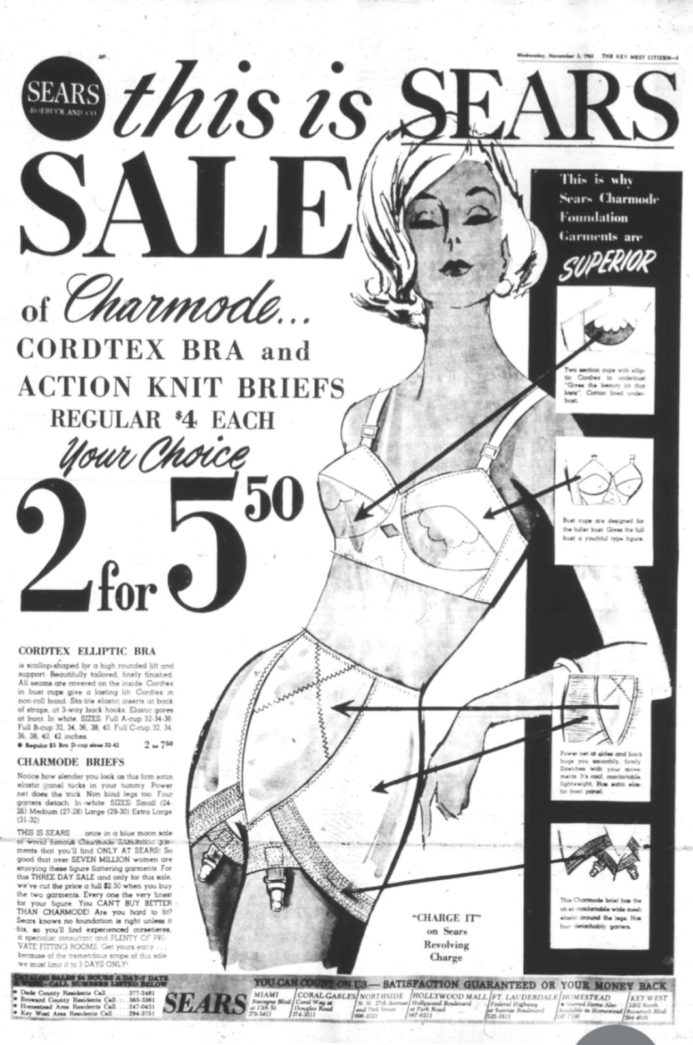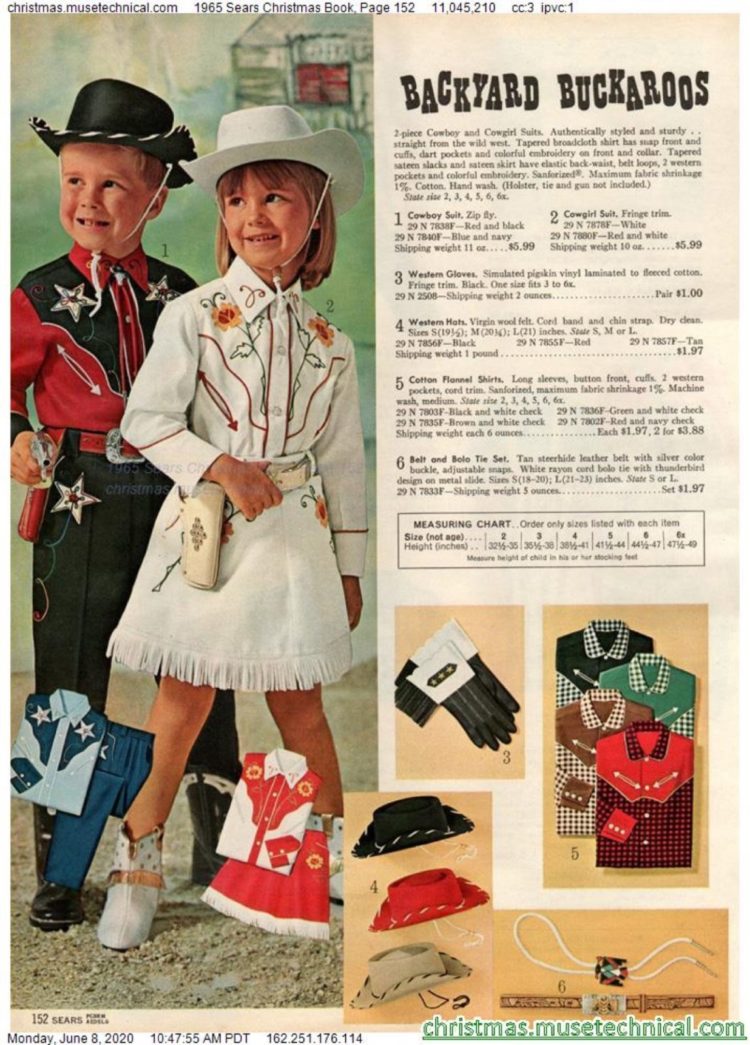The softer side of Sears is facing the hardest of times.
The Key West Sears, which opened in 1965 in the New Town shopping center that bears its name, will close on Aug. 8, according to employees, joining 3,500 other Sears and Kmart locations that have shuttered in the past 15 years, since the two companies merged in 2005. The Florida Keys Kmarts are, so far, still alive, but no one knows what will replace Sears and its adjacent Auto Center on North Roosevelt Boulevard.
“As crazy as it sounds, we haven’t yet heard anything from (Sears) corporate that they have intentions of leaving,” said Will Langley, principal broker at Berkshire Hathaway Keys Real Estate and Knight & Gardner Realty, which handles leasing at the shopping center. “We are taking names and information for potential users for Sears and the tire store.”
Langley added that there are some restrictions about what types of business can go into the vacant spaces, but declined to comment specifically.

‘GH’ gets nostagic
Gary Hall, whom most locals refer to as “GH,” could have easily preserved the bitter taste that corporate America left in his mouth in 1989. Having worked for Sears in Key West for 25 years, he bore witness to America’s corporate metamorphosis — which he still calls the “beginning of the end” for many large department chains that once operated under family-owned principles.
This month marks the end for Sears in Key West. But when Hall recollects his career with the iconic store, which began with its opening in 1965, he drifts back to moments of nostalgia — recounting decades of memories that helped shape modern-day Key West.
“Sears has quite a history in Key West,” said Hall. “We were a family there for so many years. Unfortunately it’s coming to an end.”
As a high school student in the late 1950s, Hall worked at an appliance store at 605 Simonton Street owned by Toby Bruce. It was there he would meet mentors like Roosevelt Sands, a Korean War veteran who taught Hall the skills needed for appliance repairs.
“I learned so many traits from my mentors,” said Hall with an obvious sense of pride behind the memories he spent with Mr. Sands, delivering appliances from the backs of pickup trucks on hot summer days in Key West. “Those men installed a work ethic that would serve me well throughout my life and I’m thankful for that.”
Later, Hall joined the Air Force where he served as a mechanic crew chief on C-130 airplanes. He would go on to serve three tours in Vietnam before returning to Key West. And in 1965, Hall saw a job posting for Sears and he was immediately hired as the store opener.
“I began my career with Sears in 1965 at $2 an hour and ended it in 1985 at $60,000 annually,” Hall said with a faint laugh. “The entire shopping center was built for about $1.5 million. We had a drugstore on one end and I believe Winn-Dixie was the first grocery store in the shopping center. But Sears was the anchor.”
Hall recalled a day the roof collapsed after about 20 inches of rain, which caused delays to his duties, which included stocking shelves and building displays. And once the store opened on Nov. 4, 1965 (something Hall recollects with an uncanny memory) Sears gained national attention in Key West.
“There weren’t many places for people to shop at here in 1965,” said Hall. “We had the most sales for a Sears of our size than anywhere else in the country. We literally would have customers who would run and jump over counters during sales.”
Hall’s reputation for hard work and management quickly propelled him through the ranks at Sears. After opening the store, he worked as a service technician and eventually served as assistant manager during his last 10 years. During that span, he worked for six different store managers, “some good and some not so good.”
“Everyone would tell me there is no way you can go from service technician to assistant manager,” said Hall. “They told me it couldn’t be done, but I did it. And as assistant manager, guess who ends up running the store? At one point I was handling budgets, books and a $3 million payroll with no computers. It was just a different time.”
At the height of Sears’ retail dominance in Key West, the store boasted over 300 employees with an in-house jeweler who repaired items like clocks, a candy department and an appliance department that delivered from Key West to just north of Marathon.
“You could get just about anything done at Sears back then,” said Hall. “The candy guy would make peanuts and we had 10 service vans. Our service techs would actually come out and repair televisions — back when people would still fix TVs.”
Sears will always hold a special place in Hall’s heart. All three of his sons would work in the store at some point. Chris, his youngest, sold appliances. Jay, his oldest, sold furniture, and Gary’s middle son worked delivery.
But Hall began to see the perils of corporate influence seep into the family culture that defined Sears in the mid-’80s. Rather than taking care of its own, Hall says, the company shifted to a profit model that stripped things like profit-sharing plans.
“The corporation started telling us we couldn’t hire full-time employees and I knew it was the beginning of the end,” said Hall. “But it wasn’t just in Key West and it wasn’t just Sears. It was a nationwide corporate mentality.”
Although Sears would eventually buy out Hall in 1989, he held no grudges. He would go on to contract for Sears through his furniture and appliance delivery business for seven more years. From there, he worked for the school district for another 10 years. When asked what he will miss the most about Key West’s most iconic storefront, he paused for a moment and reminisced about the people he worked with for 25 years.
“We would be a family during the good times,” said Hall. “Everyone was friendly with everybody and we had parties together. It was just one big happy family. And that’s what Sears was for so many years.”

Back in the (hey)day
Things weren’t always so tough for department stores in America.
Key West’s daily newspaper ran a series of full-page Sears ads filled with furniture, appliances and clothing for weeks prior to the southernmost store’s November 1965 opening.
The store boasted of sofas available in the ever-appealing “rust and gold tweed.”
A local newspaper article singing the praises of the new department store — and big-time advertiser — referred to “Mrs. Homemaker,” who could, and we quote, “dream and drool over model kitchens with built-in ranges.” Also, “Close by for easy coordination with her new ensemble are the shoes, attractively displayed for the foot-conscious.”
The Key West Sears also housed a beauty salon, always identifiable by the unmistakable smell of chemicals used for “perms,” where women thumbed through catalogs while sitting under a domed hair dryer.
It all sounds so innocent, outdated and, yes, sexist. But then, so was 1965.

Catalog Christmases
Anyone older than 40 recalls the days before Amazon wish lists and shared gift registries, when every September, before and throughout the 1950s, ’60s, ’70s and ’80s, the Sears Wish Book arrived in every mailbox in America and started the clock on the countdown to Christmas.
The glossy Sears holiday catalog, of course, featured its usual clothing, home appliances and Craftsman tools. But none of that mattered.
Wide-eyed and a little breathless, youngsters toted the catalog to the living room floor, sat cross-legged and flipped directly to its second half, to the pages just behind the yellow and white mail order forms that now resemble historical documents.
That’s where the magic lay. The toy section of the Sears Wish Book featured page upon page of “some assembly required” bicycles, Barbie dolls, Big Wheels, board games, Easy-Bake Ovens, rocking horses, race car tracks and action figures.
Within a day of its arrival in pristine condition, the Sears Wish Book — well, the toy section — was unrecognizable, marked as it was with circles and initials of various siblings.
Southernmost Sears
The opening of Sears was big news for the tiny island of Key West, where shopping largely had been limited to independently owned stores selling single items: shoes, groceries, women’s apparel or tools.
It was Key West businessman Edward Knight who convinced Sears & Roebuck to open a store in Key West’s new New Town area in the 1960s.
“They said Key West was too small to support a Sears,” Knight said in May 2016, three months before his death. “I told the executives to send two people down and let me show them around, that there was a different formula for doing business in Key West.”
Knight said he knew that with Sears as an anchor in the new shopping center, he could easily
fill the neighboring, smaller retail shops with local merchants.
He was right.
After the store’s first few months in Key West, Sears officials sheepishly called Knight and admitted their mistake. “They said their opening weeks here were better than they’d been in any other location,” Knight said with a wry chuckle.

Local employees recall the softer side
Women’s dresses cost $3.15 and Barbie dolls were $1.92 in 1965, when Amazon was just a river in South America.
Key West’s Searstown shopping center also included a supermarket and an F.W. Woolworth’s, with its legendary lunch counter.
Key Wester Zenaida Rojas ate countless lunches at that counter, walking down the shopping plaza during her afternoon break from Sears, where she worked from 1970 to 1991.
Rojas recalled her days at the former catalog-turned-retail-giant during a 50-year reunion of local Sears employees in 2015.
Although the retail store opened on the boulevard in November 1965, there had been a Sears catalog center downtown for years, Rojas remembered.
At the 2015 reunion, Cleo Rosam, who worked at both the catalog store and the retail department store, was crowned “Queen Bee of Sears” for her decades of service. And Ed Harris, known to customers and colleagues as “Mr. Ed” was similarly honored as “King of Sears” for his 41-year career.
“We used to have to wear pantyhose and pastel colors, but no pants, ever,” said Rojas, whose husband, Gerry, also worked at Sears in the furniture department. Her daughter, son, niece and nephew would later take up positions behind cash registers or on the sales floor at the same department store that gave rise to the island’s New Town shopping district.
Another former employee recalled the rules of customer service in the old days, reminding her fellow colleagues that “when a woman walked into a dressing room with a pair of pants or a skirt, we better have been right behind her with at least two shirts that would match.
“And, of course, all the ladies who worked in the women’s department recall the older women coming in to buy their girdles,” Rojas said, laughing at the memory of young sales girls dutifully helping to wrestle a woman into the form-fitting undergarments worn to give women a smooth silhouette.























